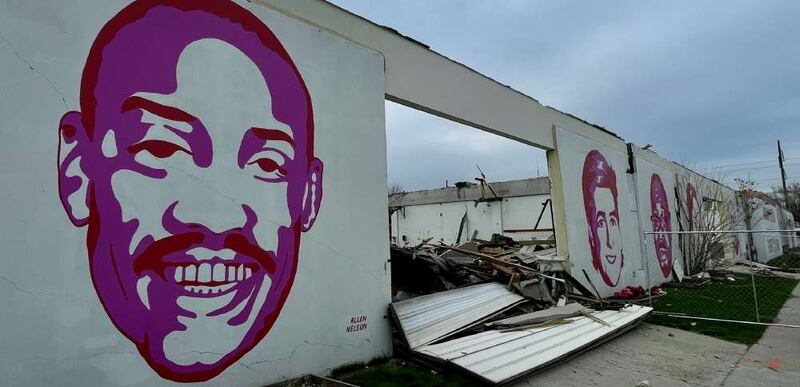Following the recently completed demolition of Salt Lake City’s old vehicle fleet buildings, which included the removal of over two dozen murals depicting people killed by police interactions, city officials on Thursday announced the next steps in renovation of the 8.75-acre city block.
“It’s been my commitment from day one, as mayor, to unlock city properties that had sat stagnant and create community benefits. This block is an eight-acre step forward toward that goal,” said Salt Lake City Mayor Erin Mendenhall. “It’s really rare for a city to have an opportunity like this one, with almost an entire city block ready to be built from the ground up — especially in Utah, where our blocks are particularly giant.”
Mendenhall said that the city is planning three separate projects for the area known as the Fleet Block. The southeast corner will include a public open space and protected bike path along 300 West, connecting to Pioneer Park.
But Thursday’s announcement was focused on the block’s two northern corners along 800 South, between 300 West and 400 West. After issuing a request for qualifications in May, the city convened a selection committee of community members, nonprofit leaders and city staff to make some decisions.
Illinois-based Brinshore Development — which has led Salt Lake City projects such as the Aster and Spark apartment buildings — has been chosen to develop the block’s northwest corner, and Mercy Housing was selected for the northeast corner.
Mercy Housing is one of the nation’s largest nonprofit affordable housing providers. The Fleet Block site marks the company’s second Utah project.
“Both of these projects include designated affordable (housing) units and thoughtful amenities for their residents,” Mendenhall said.
The developments will also incorporate the city’s first-ever community benefits agreement.
“That means that the people who live here and work here will be in the driver’s seat, deciding what future features and amenities they want to see in these developments. That could be more public art, better lighting or space for local small businesses,” Mendenhall said. “The point is that it’s going to be shaped by the people who know this neighborhood best.”
She said the long-vacant lot will soon be a bridge between communities, brimming with “affordable homes, welcoming green space and public art that honors its history as a space where social justice matters.”
In March, Sofia Jeremias, spokeswoman for the Salt Lake City Department of Community and Neighborhoods, said somehow removing the murals that depicted numerous people killed in interactions with police would have been “prohibitively expensive.”
Instead, the city commissioned professional photos of the murals, which were shared with family members, and also posted three-dimensional imagery of the buildings prior to demolition online.
What is the plan to continue honoring the individuals whose portraits were on the now-demolished buildings? Mendenhall said community engagement is happening with the families and the community members who are most closely tied to the individuals depicted on the murals.
“They are all being involved in the development of what will be an arts RFP, a request for proposals for artists in the community to create depictions and installations. What the artists will bring up, we’re anxious to see, but I know that will be part of the input that the community is giving and that the artists receive,” Mendenhall said.
Shelly Marquez, president of Mercy Housing’s Mountain Plains region, said the next year of development will primarily be focused on community engagement. Marquez added that construction could start in the fourth quarter of 2026 or the first quarter of 2027.
“We want to be very thoughtful in our approach and make sure that we’ve got the right partners at the table, and we’ve engaged the community in a way that is meaningful — that they felt like they’ve been heard — and that we’re developing a community benefits agreement that meets the needs for all partners involved,” she said.

